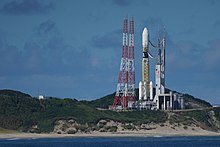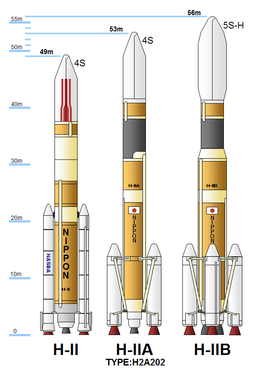H-IIB
 H-IIB No. F8 at the launch pad in September 2019 | |
| Function | Medium-lift launch vehicle |
|---|---|
| Manufacturer | Mitsubishi Heavy Industries |
| Country of origin | Japan |
| Cost per launch | US$112.5 million[1] |
| Size | |
| Height | 56.6 m (186 ft) |
| Diameter | 5.2 m (17 ft) |
| Mass | 531,000 kg (1,171,000 lb) |
| Stages | 2 |
| Capacity | |
| Payload to LEO | |
| Mass | 19,000 kg (42,000 lb)[2] |
| Payload to ISS (carrying the HTV) | |
| Mass | 16,500 kg (36,400 lb)[3] |
| Payload to GTO | |
| Mass | 8,000 kg (18,000 lb)[4] |
| Associated rockets | |
| Family | H-II family |
| Based on | H-II, H-IIA |
| Derivative work | H3 |
| Comparable | |
| Launch history | |
| Status | Retired |
| Launch sites | Tanegashima, LA-Y2 |
| Total launches | 9 |
| Success(es) | 9 |
| First flight | 10 September 2009 |
| Last flight | 20 May 2020 |
| Type of passengers/cargo | H-II Transfer Vehicle |
| Boosters – SRB-A3 | |
| No. boosters | 4 |
| Height | 15 m (49 ft) |
| Diameter | 2.5 m (8 ft 2 in) |
| Gross mass | 76,500 kg (168,700 lb) each |
| Propellant mass | 66,000 kg (146,000 lb) each |
| Maximum thrust | 2,305 kN (518,000 lbf) |
| Total thrust | 9,220 kN (2,070,000 lbf) |
| Specific impulse | 283.6 s (2.781 km/s) |
| Burn time | 114 seconds |
| Propellant | HTPB |
| First stage | |
| Height | 38 m (125 ft) |
| Diameter | 5.2 m (17 ft) |
| Gross mass | 202,000 kg (445,000 lb) |
| Propellant mass | 177,800 kg (392,000 lb) |
| Powered by | 2 × LE-7A |
| Maximum thrust | 2,196 kN (494,000 lbf) |
| Specific impulse | 440 seconds (4.3 km/s) |
| Burn time | 352 seconds |
| Propellant | LH2 / LOX |
| Second stage | |
| Height | 11 m (36 ft) |
| Diameter | 4.0 m (13.1 ft) |
| Gross mass | 20,000 kg (44,000 lb) |
| Propellant mass | 16,600 kg (36,600 lb) |
| Powered by | 1 × LE-5B |
| Maximum thrust | 137 kN (31,000 lbf) |
| Specific impulse | 448 s (4.39 km/s) |
| Burn time | 499 seconds |
| Propellant | LH2 / LOX |
H-IIB (H2B) was an expendable space launch system jointly developed by the Japanese government's space agency JAXA and Mitsubishi Heavy Industries. It was used to launch the H-II Transfer Vehicle (HTV, or Kōnotori) cargo spacecraft for the International Space Station. The H-IIB was a liquid-fueled rocket, with solid-fuel strap-on boosters and was launched from the Tanegashima Space Center in southern Japan. H-IIB made its first flight in 2009, and had made a total of nine flights through 2020 with no failures.
H-IIB was able to carry a payload of up to 8,000 kg (18,000 lb) to Geostationary transfer orbit (GTO),[4] compared with the payload of 4000–6000 kg for the H-IIA, a predecessor design. Its performance to low Earth orbit (LEO) was sufficient for the 16,500 kg (36,400 lb) H-II Transfer Vehicle (HTV).[4] The first H-IIB was launched in September 2009 and the last H-IIB was launched in May 2020.[4]
Development
[edit]
The H-IIB was a space launch vehicle jointly designed, manufactured and operated by JAXA and Mitsubishi Heavy Industries to launch the H-II Transfer Vehicle. The system was designed to adopt methods and components that have already been verified by flights on the H-IIA, so that manufacturing the new launch vehicle would be more cost-effective, with less risk, in a shorter period of time. JAXA was in charge of preliminary design, readiness of the ground facility, and the development of new technologies for the H-IIB, in which the private sector has limited competencies, while the Mitsubishi Heavy Industries was responsible for manufacturing. JAXA successfully conducted eight firing tests of the new cluster design with the simulated first-stage propulsion system, called Battleship Firing Tests, since March 2008, at MHI's Tashiro Test Facility in Ōdate, Akita Prefecture.[5]
Before launch, two Captive Firing Tests were conducted on the H-IIB. The first test, which consisted of firing the first stage for ten seconds, was originally scheduled to occur at 02:30 UTC on 27 March 2009, however it was cancelled after the launch pad's coolant system failed to activate.[6] This was later discovered to have been due to a manual supply valve not being open.[7] The test was rescheduled for 1 April 2009, but then postponed again due to a leak in a pipe associated with the launch facility's fire suppression system.[8] The test was rescheduled for 2 April 2009,[9] when it was successfully conducted at 05:00 UTC.[10] Following this, the second test, which involved a 150-second burn of the first stage, was scheduled for 20 April.[11] This was successfully conducted at 04:00 UTC on 22 April 2009,[12] following a two-day delay due to unfavorable weather conditions.[13] A ground test, using a battleship mockup of the rocket was subsequently conducted on 11 July 2009.[14]
By 2009, the development program of the H-IIB had cost approximately 27 billion yen.[15]
Vehicle description
[edit]The H-IIB launch vehicle was a two-stage rocket. The first stage used liquid oxygen and liquid hydrogen as propellants and had four strap-on solid rocket boosters (SRB-A3) powered by polybutadiene. The first stage was powered by two LE-7A engines, instead of one for the H-IIA. It had four SRB-As attached to the body, while the standard version of H-IIA had two SRB-As. In addition, the first-stage body of the H-IIB was 5.2 m in diameter compared with 4 m for the H-IIA. The total length of the first stage was extended by 1 m from that of H-IIA. As a result, the H-IIB first stage held 70% more propellant than that of the H-IIA. The second stage was powered by a single LE-5B engine, which was also propelled by a hydrogen/oxygen fuel and oxidizer.[16]
Launch history
[edit]The first launch of the H-IIB occurred on 10 September 2009 at 17:01:46 UTC. It successfully launched the HTV-1, which was on a mission to resupply the International Space Station (ISS).[17]
| Flight | Date of Launch (UTC) | Payload | Remarks | Result |
|---|---|---|---|---|
| TF1 | 10 September 2009 17:01:46 |
HTV-1 | H-IIB flight test HTV demonstration flight |
Success |
| F2 | 22 January 2011 05:37:57 |
Kounotori 2 | Success | |
| F3 | 21 July 2012 02:06:18 |
Kounotori 3 | Success | |
| F4 | 3 August 2013 19:48:46 |
Kounotori 4 | Success | |
| F5 | 19 August 2015 11:50:49 |
Kounotori 5 | Success | |
| F6 | 9 December 2016 13:26:47 |
Kounotori 6 | Success | |
| F7 | 22 September 2018 17:52:27 |
Kounotori 7 | Success | |
| F8 | 24 September 2019 16:05:05 |
Kounotori 8 | Success | |
| F9 | 20 May 2020 17:31:00 |
Kounotori 9 | Final flight of H-IIB Final flight of HTV |
Success |
See also
[edit]References
[edit]- ^ "Surplus Missile Motors: Sale Price Drives Potential Effects on DOD and Commercial Launch Providers". Government Accountability Office. 16 August 2017. Retrieved 8 September 2024.
- ^ SASAKI, Hiroshi; IMADA, Takane; TAKATA, Shinichi (2009). "Development Plan for Future Mission from HTV System". Transactions of the Japan Society for Aeronautical and Space Sciences, Space Technology Japan. 7 (ists26): Tk_77–Tk_82. doi:10.2322/tstj.7.Tk_77. ISSN 1347-3840.
- ^ "About H-IIB Launch Vehicle". Japan Aerospace Exploration Agency. JAXA. Retrieved 18 September 2019.
- ^ a b c d Krebs, Gunter. "H-2B". Gunter's Space Page. Retrieved 28 January 2017.
- ^ "A new stage in Japanese space transportation". Tomihisa Nakamura. JAXA. 15 July 2007. Retrieved 10 September 2009.
- ^ "Postponement of the First Captive Firing Test (CFT) of the First Stage Flight Model Tank for the H-IIB Launch Vehicle". JAXA. 27 March 2009. Archived from the original on 15 March 2012. Retrieved 12 August 2009.
- ^ "The First Captive Firing Test for the First Stage Flight Model Tank for the H-IIB Launch Vehicle". JAXA. 30 March 2009. Archived from the original on 15 March 2012. Retrieved 12 August 2009.
- ^ "Suspension of the First Captive Firing Test (CFT) of the First Stage Flight Model Tank for the H-IIB Launch Vehicle". JAXA. 1 April 2009. Archived from the original on 15 March 2012. Retrieved 12 August 2009.
- ^ "The First Captive Firing Test for the First Stage Flight Model Tank for the H-IIB Launch Vehicle". JAXA. 1 April 2009. Archived from the original on 15 March 2012. Retrieved 12 August 2009.
- ^ "Result of the First Captive Firing Test for the First Stage Flight Model Tank of the H-IIB Launch Vehicle". JAXA. 2 April 2009. Archived from the original on 14 September 2009. Retrieved 12 August 2009.
- ^ "The Second Captive Firing Test for the First Stage Flight Model Tank for the H-IIB Launch Vehicle". JAXA. 17 April 2009. Archived from the original on 15 March 2012. Retrieved 12 August 2009.
- ^ "Result of the Second Captive Firing Test for the First Stage Flight Model Tank of the H-IIB Launch Vehicle". JAXA. 22 April 2009. Archived from the original on 25 April 2009. Retrieved 12 August 2009.
- ^ "Postponement of the Second Captive Firing Test (CFT) of the First Stage Flight Model Tank for the H-IIB Launch Vehicle". JAXA. 19 April 2009. Archived from the original on 15 March 2012. Retrieved 12 August 2009.
- ^ "Results of the H-IIB Launch Vehicle Ground Test Vehicle (GTV) Test". JAXA. 11 July 2009. Archived from the original on 15 July 2009. Retrieved 12 August 2009.
- ^ JAXA、H-IIBロケットの
地上 総合 試験 (GTV)について説明 , Robot Watch, 2009-7-10 - ^ "H-IIB" (PDF). H-IIB Launch Vehicle. Japanese Aerospace Exploration Agency. 15 July 2009. Archived from the original (PDF) on 26 March 2014. Retrieved 4 September 2009.
- ^ "Japan's space freighter in orbit". Jonathan Amos. BBC. 10 August 2009. Retrieved 10 September 2009.
External links
[edit]- JAXA | H-IIB Launch Vehicle Archived 26 March 2014 at the Wayback Machine
- "Development Status of the H-IIB Launch Vehicle". Mitsubishi Heavy Industries Technical Review Volume 45 Number 4
- H-2B rocket 3D model

